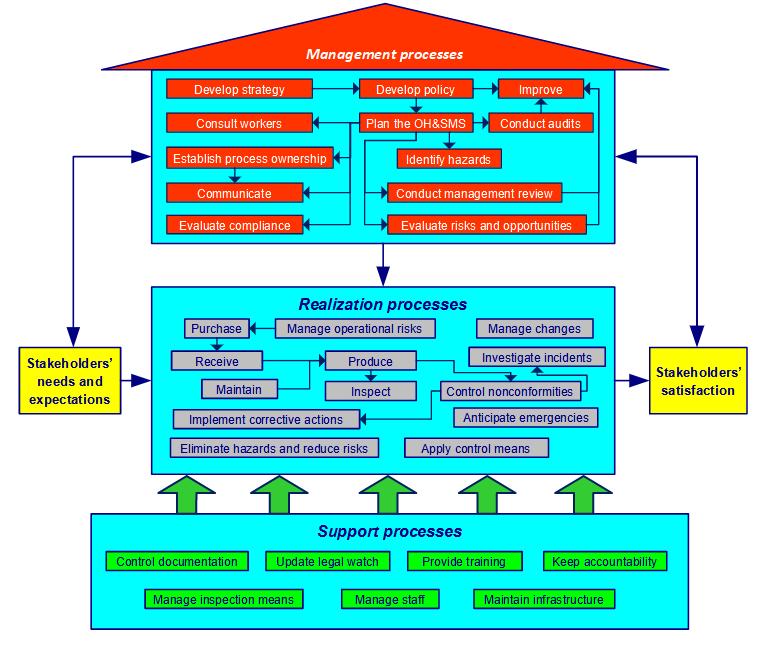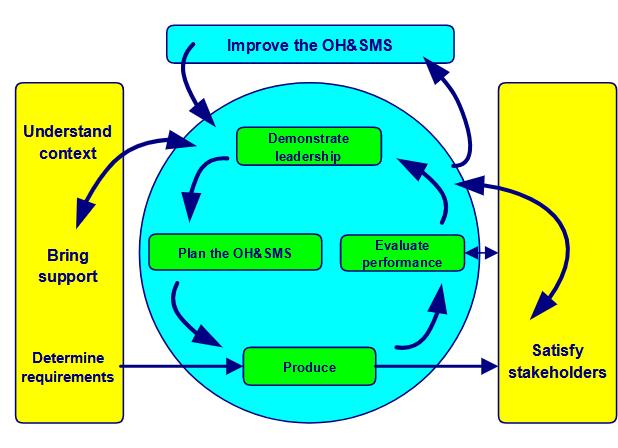3 Process approach T 18
3.1 Process
Process types, management, realization and support processes

The word processactivities which transform inputs into outputs (see also ISO 9000, 3.4.1) comes from the Latin root procedere = go, development, progress (Pro = forward, cedere = go). Each processactivities which transform inputs into outputs (see also ISO 9000, 3.4.1) transforms inputs into outputs, creating added value and potential nuisances.
A processactivities which transform inputs into outputs (see also ISO 9000, 3.4.1) has three basic elements: inputs, activities and outputs. .jpg)
A processactivities which transform inputs into outputs (see also ISO 9000, 3.4.1) can be very complex (launch a rocket) or relatively simple (audit a productany outcome of a process or activity (see also ISO 9000, 3.4.2)). A processactivities which transform inputs into outputs (see also ISO 9000, 3.4.1) is:
- repeatable
- foreseeable
- measurable
- definable
- dependent on its context
- responsible for its external providers
A processactivities which transform inputs into outputs (see also ISO 9000, 3.4.1) is, among other things, determined by its:
- title and type
- purpose (why?)
- beneficiary (for whom?)
- scope and activities
- initiators
- documentation
- inputs
- outputs (intentional and not intentional)
- constrains
- people
- material resources
- objectives and indicators
- person in charge (owner) and actors (participants)
- means of inspection (monitoring, measurement)
- mapping
- interaction with other processes
- risks and potential deviations
- opportunities for continual improvement
A processactivities which transform inputs into outputs (see also ISO 9000, 3.4.1) review is conducted periodically by the processactivities which transform inputs into outputs (see also ISO 9000, 3.4.1) owner (cf. annex 03). .jpg)

The components of a process are shown in figure 3-1:

Figure 3-1. Components of a process
Figure 3-2 shows an example that helps to answer some questions:
- which materials, which documents, which tooling? (inputs)
- which title, what objective, which activities, requirements, constraints? (process)
- which products, which documents? (outputs)
- how, which inspections? (methods)
- what is the level of performance? (indicators)
- who, with what competence? (people)
- with what, which machines, which equipment? (material resources)

Figure 3-2. Some elements of a process
Often the output of a processactivities which transform inputs into outputs (see also ISO 9000, 3.4.1) is the input of the next processactivities which transform inputs into outputs (see also ISO 9000, 3.4.1).

Any organizationa structure that satisfies a need (see also ISO 9000, 3.3.1) (company) can be considered as a macro processactivities which transform inputs into outputs (see also ISO 9000, 3.4.1), with its purpose, its inputs (customeranyone who receives a product (see also ISO 9000, 3.3.5) needs and expectations) and its outputs (products/services to meet customeranyone who receives a product (see also ISO 9000, 3.3.5) requirementsexplicit or implicit need or expectation (see also ISO 9000, 3.1.2)).
Our preference is to identify a processactivities which transform inputs into outputs (see also ISO 9000, 3.4.1) using a verb (buy, produce, sell) instead of a noun (purchases, production, sales) to differentiate the processactivities which transform inputs into outputs (see also ISO 9000, 3.4.1) of the company's department or procedure to maintain and recall the purpose of the processactivities which transform inputs into outputs (see also ISO 9000, 3.4.1).
The processes are (as we shall see in the following paragraphs) of management, realization and support type. Do not attach too much importance to processactivities which transform inputs into outputs (see also ISO 9000, 3.4.1) categorizing (sometimes it's very relative) but ensure that all of the company's activities fall into at least one processactivities which transform inputs into outputs (see also ISO 9000, 3.4.1).
3.1.1 Management processes
The following processes can be part of this family:
- develop strategy
- develop policy
- deploy objectives
- plan the OH&SMS
- consult workers
- identify hazards
- assess risks and opportunities
- evaluate compliance
- establish process ownership
- conduct an audit
- conduct management review
- communicate
- improve
3.1.2 Realization processes
They are mainly:
- purchase
- produce
- manage operational risks
- eliminate hazards and reduce risks
- apply control means
- manage changes
- inspect (verify) the performance
- receive, store and deliver
- control nonconformities
- investigate incidents
- anticipate emergencies
- implement corrective actions
3.1.3 Support processes
The support processes are often:
- control documentation
- provide training
- acquire and maintain infrastructure
- keep the legal watch up-to-date
- manage inspection means
- keep accountability
- manage staff
3.2 Process mapping
Process mapping and house

Par excellence processactivities which transform inputs into outputs (see also ISO 9000, 3.4.1) mapping is a multidisciplinary work. This is not a formal requirementexplicit or implicit need or expectation (see also ISO 9000, 3.1.2) of the ISO 45001 standard but is always welcome.
The three types of processes and some interactions are shown in figure 3-3:

Figure 3-3. Process house
Examples of stakeholders: investors, customers, employees, suppliers and society.
Do not underestimate the costs associated with hazards and risks.
The mapping, among other things, allows you to:
- obtain a global vision of the organization
- identify the beneficiaries (customers), flows and interactions
- define rules (simple) for communication between processes
To obtain a clearer picture you can simplify by using a total of about 15 core processes. A core processactivities which transform inputs into outputs (see also ISO 9000, 3.4.1) can have several sub-processes. For example, a processactivities which transform inputs into outputs (see also ISO 9000, 3.4.1) "develop the OH&SMS" can contain: .jpg)
- develop strategy
- develop policy
- manage risks
- plan the OH&SMS
- deploy objectives
- acquire resources
- establish process ownership
- improve
Two other processactivities which transform inputs into outputs (see also ISO 9000, 3.4.1) examples ("design", figure 3-4 and "produc"e, figure 3-5) are: .jpg)
.jpg)
Figure 3-4. Design process

Figure 3-5. Produce process
.jpg) Minute of relaxation. Game: Process
Minute of relaxation. Game: Process
3.3 Process approach
Process approach and continual improvement

Simple solutions for now, perfection for later
The process approachmanagement by the processes to better satisfy customers, improve the effectiveness of all processes and increase global efficiency (see also ISO 9004, Annexe B.5) contributes enormously to the efficient management of the organization.
Process approach: management by the processes to better satisfy customers, improve the effectiveness of all processes and increase global efficiency
When the process approachmanagement by the processes to better satisfy customers, improve the effectiveness of all processes and increase global efficiency (see also ISO 9004, Annexe B.5) is included during the development, implementation and continual improvementpermanent process allowing the improvement of the global performance of the organization (see also ISO 9000, 3.2.13 and ISO 14 001, 3.2) of an OH&S management system, it allows one to achieve objectives that are related to satisfaction of stakeholders, as is shown in figure 3-6.

Figure 3-6. Model of an OH&SMS based on process approach and continual improvement
The process appraoch:
- emphasizes the importance of:
- understanding and complying with stakeholders' requirements
- prevention so as to react to unwanted elements such as:
- incidents
- accidents
- measuring process performance, effectiveness and efficiency
- permanently improving objectives based on pertinent measurements
- process added value
- relies on:
- methodical identification
- interactions
- the sequence and
- process management, which consists of:
- determining objectives and action plans
- directing related activities
- analyzing obtained results
- permanently undertaking improvement
- allows one to:
- better view inputs and outputs and their relationship
- clarify roles and responsibilities
- judiciously assign necessary resources
- break down the barriers between departments
- decrease costs, delays and waste
- and ensures in the long run:
- control
- monitoring and
- continual improvement of processes
- crisis management ("You will not solve the problems by addressing the effects")
- blaming people ("Poor quality is the result of poor management." Masaaki Imai)
- prioritizing investments ("Use your brain, not your money." Taiichi Ohno)
 Minute of relaxation. Paganini's violin concert performed with facial expressions.
Minute of relaxation. Paganini's violin concert performed with facial expressions.
